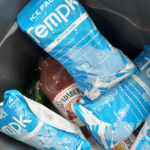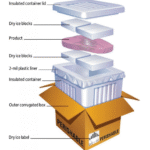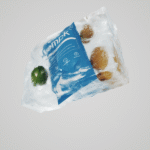Every year about one third of the food produced for human consumption is lost or wasted—around 1.3 billion tonnes globally. In Africa alone, up to 40 % of perishable crops spoil after harvest. Cold chain agriculture—the practice of maintaining precise temperatures from farm to plate—addresses this crisis by preserving quality and reducing waste. Without robust temperature control, microbial growth accelerates and spoilage rates soar; in some regions improper cold chain management accounts for up to 50 % of food waste. This guide explains why the cold chain matters, كيف يعمل, and how you can leverage it to protect your produce, profits, والكوكب. Updated for 2025, the article draws on current research and practical examples.

What is cold chain agriculture and why does it matter? A simple explanation with statistics on global food waste and post harvest losses.
How does cold chain logistics protect perishable food? An overview of temperature control, العبوة الذكية, مراقبة إنترنت الأشياء, وأفضل الممارسات.
What benefits can farmers, retailers, and consumers expect? Discussion of improved profits, market access, and food safety.
What challenges do cold chains face and how can they be solved? Look at infrastructure gaps, energy demands, and sustainability issues, with strategies to overcome them.
ما هي أحدث الاتجاهات في 2025? Insights into renewable powered storage, AI driven demand forecasting, and green refrigerants.
Why Does Cold Chain Agriculture Matter for Food Security?
Preserves scarce resources. Every year billions of tonnes of food never reach a plate, either rotting in the field or spoiling in storage. The Food and Agriculture Organization estimates that cutting post harvest losses by just 25 ٪ could feed more than 200 million people. Without a cold chain, perishable products like fruits, خضروات, لحمة, and dairy quickly deteriorate due to temperature fluctuations. The result is huge wastage of water, أرض, تَعَب, and energy.
Improves environmental sustainability. Food waste contributes roughly 8–10 % of global greenhouse gas emissions. Landfills full of decomposing organic matter emit methane, a potent greenhouse gas. من خلال الحفاظ على درجات حرارة منخفضة ثابتة, cold chain systems slow spoilage and reduce the volume of food sent to landfill. Cutting global food waste in half could reduce emissions by 1.5 gigatons per year—equivalent to taking millions of cars off the road.
Enhances economic returns. Post harvest losses cost African economies about US$ 4 billion سنويا. Farmers lose income when surplus produce spoils before reaching markets. Consumers pay more for scarce fresh food, while retailers shoulder the cost of disposing of expired inventory. Cold chains help stabilize supply, increasing both farmer profits and consumer access. Kenya’s avocado exports, على سبيل المثال, surged after investments in cold chain facilities and compliance training, enabling access to high value European and Middle Eastern markets.
Supports food safety and nutrition. When meat, ألبان, and fresh produce are held outside their optimal temperature ranges, pathogenic bacteria multiply rapidly. Cold chains reduce foodborne illness and retain nutrients by limiting microbial growth, which is essential in protecting vulnerable populations like children and the elderly.
How Does Cold Chain Agriculture Work?
Cold chain agriculture involves coordinated temperature control from harvest through consumption. It requires specialized infrastructure, معدات, and protocols to ensure that perishable goods remain within safe temperature ranges throughout the supply chain.
Key Components of the Agricultural Cold Chain
| عنصر | Role | فائدة عملية |
| Pre cooling | Rapidly lowers produce temperature immediately after harvest to slow respiration and decay. | Extends shelf life and maintains quality, allowing growers to transport products over longer distances. |
| التخزين البارد | Insulated warehouses or on farm storage units equipped with refrigeration systems. | Provides a buffer against market fluctuations, enabling farmers to delay sales until prices improve. |
| النقل الذي يتم التحكم في درجة حرارته | شاحنات مبردة, الحاويات, and rail cars that maintain consistent temperatures. | Prevents spoilage and contamination during transit. |
| Monitoring and traceability systems | أجهزة الاستشعار, سجلات البيانات, أجهزة إنترنت الأشياء, and blockchain platforms that record temperature, رطوبة, والموقع. | Enables real time monitoring, quick response to deviations, and transparency for all stakeholders. |
| Temperature resilient packaging | Modified atmosphere packaging, الصناديق المعزولة, حزم هلام, and smart tags. | Minimizes temperature fluctuations and provides visual cues when conditions exceed safe limits. |
How Cold Chains Prevent Waste
Spoilage occurs when perishable goods experience temperatures outside their recommended range. Cold chain failures—whether from equipment malfunctions, انقطاع التيار الكهربائي, or logistical delays—allow temperatures to rise, accelerating microbial growth. أ 2021 Food and Agriculture Organization report notes that improper temperature management can cause up to half of food waste in some regions. Maintaining a consistent cold chain involves:
Reliable refrigeration systems. Investing in modern, energy efficient cooling equipment reduces the risk of breakdowns. Regular maintenance and backup generators help avoid downtime during power failures.
Continuous temperature monitoring. IoT sensors and data loggers provide real time visibility. Alerts notify operators when temperatures deviate from setpoints, enabling quick corrective actions.
Smart packaging solutions. Modified atmosphere packaging, البطانيات الحرارية, and gel packs insulate products and maintain the cold environment during hand offs.
Training and protocols. Personnel must understand the importance of maintaining the cold chain. التحميل السليم, التفريغ, and handling practices prevent accidental exposure to ambient temperatures.
Smart Technologies Transforming Cold Chains
Recent advances are making cold chains more efficient and accessible:
إنترنت الأشياء (إنترنت الأشياء) devices continuously monitor temperature, رطوبة, والموقع, sending alerts if deviations occur.
الذكاء الاصطناعي (منظمة العفو الدولية) and machine learning analyze data to forecast demand, تحسين الطرق, والتنبؤ بأعطال المعدات.
بلوكتشين provides tamper proof records of a product’s journey, enhancing traceability and consumer confidence.
العبوة الذكية includes indicators that change colour if temperature thresholds are exceeded, allowing quick removal of compromised products.
Precision agriculture tools and real time tracking improve adaptive capacity; cold chain facilities paired with these technologies help supply chains respond to disruptions.
Benefits of Cold Chain Agriculture for Farmers, تجار التجزئة, and Consumers
Farmers: Reduced Losses and Higher Income
Cut waste and increase sales. Effective cold chain management can reduce post harvest losses by up to 40 ٪—as demonstrated in Nigeria where refrigeration technologies and electric cold chain investments cut losses by about 40 ٪. Farmers sell more of what they produce, boosting revenue.
Access premium markets. Buyers in high value export markets demand consistent quality and compliance with safety standards. Cold chain systems enable farmers to meet these requirements, leading to higher prices for their products.
Leverage timing. With reliable cold storage, producers can hold products until market prices peak instead of rushing to sell before spoilage.
Improve negotiating power. Maintaining product quality gives farmers leverage when negotiating with buyers or aggregators.
تجار التجزئة: Lower Costs and Stronger Brand Trust
Reduce shrinkage. Retailers often discard produce that spoils before sale. Cold chains keep inventory fresh, reducing shrinkage and saving on procurement costs.
Enhance brand reputation. Consumers associate consistent quality and safety with reliability. Proper cold chain management helps build trust and loyalty.
Optimize logistics. Real time monitoring and predictive analytics enable precise replenishment schedules, lowering storage costs and minimizing stockouts.
المستهلكين: Fresher, Safer Food
Better quality. Perishable foods retain flavour, نَسِيج, and nutrients when stored at optimal temperatures.
Improved safety. Cold chains slow bacterial growth, reducing the risk of foodborne illness.
Reduced waste at home. Products with longer shelf life give households more time to consume them, reducing household food waste.
Challenges and Solutions in Cold Chain Agriculture
Despite its benefits, cold chain agriculture faces several challenges. Recognizing these hurdles is the first step toward building resilient solutions.
High Initial Investment
Setting up cold storage facilities, purchasing refrigerated vehicles, and installing monitoring systems require significant capital. Smallholder farmers often lack access to credit or financing. Public private partnerships, cooperative models, and micro financing schemes can bridge this gap. In Nigeria, assessments of pilot cold chain projects showed that refrigeration technologies reduced post harvest losses by 40 %, underscoring the value of targeted investments. Governments and development agencies can support such pilots and scale successful models.
Energy Access and Sustainability
Maintaining cold temperatures demands reliable energy. In rural areas where grid power is unreliable, renewable energy solutions like solar powered micro grids provide an alternative. The economic butterfly effect study notes that cold chain infrastructure using smart logistics prevents wastage by maintaining appropriate temperatures. Integrating renewable energy sources and energy efficient technologies reduces operating costs and environmental impacts. Emerging refrigerants with low global warming potential (GWP) further enhance sustainability.
Infrastructure and Transportation Gaps
Poor roads, limited ports, and inadequate distribution networks hinder the movement of refrigerated goods. Governments must prioritize infrastructure development, while businesses can invest in community based cold rooms and decentralized storage. Drones and autonomous vehicles—already in pilot stages—promise to expand cold chain coverage in hard to reach regions.
Training and Human Capacity
Lack of awareness about proper handling can lead to accidental exposure to warm temperatures. Training programs for farmers, السائقين, and warehouse staff are crucial. Simple steps like avoiding frequent door openings, loading goods quickly, and monitoring fuel and coolant levels can make a significant difference.
Access Inequality
While large agribusinesses rapidly adopt cold chain technologies, smallholder farmers risk being left behind. Precision agriculture tools, cold chain facilities and real time tracking enhance adaptive capacity, but costs and technical complexity can be barriers. Community cooperatives, shared infrastructure, and government subsidies help democratize access. Policies should support inclusive growth to avoid widening the gap between large exporters and small producers.
Implementing Cold Chain Agriculture: Practical Guidance
تقييم احتياجاتك
Begin by mapping your current supply chain. Identify where spoilage occurs and which products are most vulnerable. Consider factors such as harvest volume, distance to market, and the expected shelf life of your crops. على سبيل المثال, berries and leafy greens require rapid cooling and near freezing storage, whereas root vegetables tolerate slightly higher temperatures.
Choose Appropriate Technology
Not all cold chain solutions fit every situation. When selecting technology:
الحجم يهم. Micro cold rooms or portable coolers may suit small farms, while large cooperatives might invest in central storage facilities.
Energy source. Evaluate grid reliability and explore renewable options like solar, biogas, or hybrid systems.
Monitoring capability. Opt for systems with built in sensors that offer real time temperature and humidity data. Access to dashboards via mobile devices helps quickly respond to issues.
Packaging solutions. استخدم الحاويات المعزولة, البطانيات الحرارية, or phase change materials to maintain temperature during transit. Smart labels that change colour when the cold chain is compromised provide instant feedback.
Strengthen Logistics and Coordination
Cold chain success depends on coordinated timing among farmers, الناقلون, المستودعات, وتجار التجزئة. Implement demand forecasting and inventory management systems to align production with market needs. Just in time inventory approaches, though risky, minimize holding costs and waste by aligning supply with actual demand. Partner with logistics providers who specialize in refrigerated transport and ensure they have contingency plans for delays or breakdowns.
Collaborate and Share Resources
Smallholder farmers may not individually afford cold chain infrastructure. Forming cooperatives allows members to pool resources for shared storage and transportation. Governments can subsidize such initiatives or provide grants and low interest loans to encourage adoption. In Nigeria, electric cold chain investments tripled between 2020 و 2024 and reduced post harvest losses by 40 %. Such collaborative investments have multiplier effects—improved incomes, local employment and stronger food security.
Include Renewable Energy and Sustainability Measures
Renewable energy can supply consistent power while reducing costs and emissions. Solar powered cold rooms, biogas generators, and phase change materials that store thermal energy are increasingly viable. Pairing cold chain infrastructure with micro grids enhances rural electrification, benefiting communities beyond agriculture.
Develop a Crisis Plan
Despite best efforts, disruptions occur. Create contingency plans that include backup generators, alternative transport routes, and procedures for transferring products quickly to alternative cold storage when equipment fails. Having insurance policies for perishable goods can help mitigate financial losses.
دراسات الحالة: Real World Impact
Nigeria’s Cold Chain Pilots
The Food and Agriculture Organization assessed several cold chain pilot projects in Nigeria. Refrigeration technologies in these pilots reduced post harvest losses by 40 %. A subsequent expansion of electric cold chain infrastructure tripled the level of 2020 investment and further reduced losses. The pilots created new jobs in transportation and maintenance, improved farmer incomes, and stabilized urban food supplies.
Kenya’s Avocado Export Boom
Kenya invested in cold chain facilities and compliance training for avocado exporters. Post harvest handling improved, enabling shipments to meet strict European Union and Middle Eastern standards. Exports surged, and farmers received premium prices. The success story illustrates how cold chain investments unlock access to high value markets.
Rwanda’s Hermetic Storage Success
While not strictly refrigeration, Rwanda’s adoption of hermetic storage bags shows how simple technology reduces losses. These airtight bags decreased maize post harvest losses from 22 % to 5 %. The bags protect against moisture and pests, demonstrating how low cost interventions complement cold chain efforts.
2025 Trends in Cold Chain Agriculture
يتطور مشهد سلسلة التبريد بسرعة. Here are the key trends shaping 2025 وما وراءها:
Renewable Powered Micro Cold Rooms
Solar powered cold rooms are becoming mainstream in regions with unreliable grids. Companies offer modular units that farmers can lease, reducing capital outlay. Batteries or phase change materials store energy, providing cooling overnight. These systems address both energy access and sustainability concerns.
AI Driven Demand Forecasting
Artificial intelligence and machine learning analyze weather patterns, social media trends, and historical sales to predict demand more accurately. This improves production planning, reduces over production, and aligns the cold chain’s capacity with market needs.
Green Refrigerants and High Efficiency Equipment
تعمل اللوائح على التخلص التدريجي من المبردات ذات القدرة العالية على إحداث الاحترار العالمي. المبردات الطبيعية مثل الأمونيا, ثاني أكسيد الكربون, and hydrocarbons are gaining popularity. New compressor technologies improve energy efficiency, cutting operating costs and emissions.
Smart Packaging and Biosensors
Smart labels with embedded biosensors detect ripeness, microbial activity, and temperature breaches. Consumers and retailers can assess product freshness at a glance, reducing unnecessary disposal and enabling dynamic pricing.
Decentralized Logistics Platforms
Blockchain based platforms enable small producers to access shared refrigerated transport on demand. Digital marketplaces match producers with available cold chain capacity, increasing utilization and lowering costs.
Policy Support and Carbon Credits
Governments and international organizations are incentivizing cold chain adoption through subsidies, tax breaks, and carbon credit schemes. Post harvest loss reduction is recognized as a climate smart strategy in national climate plans. Businesses that cut waste can earn carbon credits, creating an additional revenue stream.
الأسئلة المتداولة
What is the difference between food loss and food waste? Food loss happens during production, harvest, تخزين, and transport—such as maize spoiling in a silo due to moisture—whereas food waste occurs at retail and consumer levels, for example when supermarkets discard unsold produce.
How much food is lost or wasted each year? Approximately one third of food produced for human consumption—about 1.3 billion tonnes- يتم فقدانها أو إهدارها سنويًا.
How do cold chain failures occur? Failures arise from equipment malfunctions, انقطاع التيار الكهربائي, or delays that expose products to unsafe temperatures. Lack of monitoring and poor handling practices also contribute.
Can smallholder farmers afford cold chain technology? Cooperative models, micro financing, and renewable powered micro cold rooms can make cold chain solutions affordable. Investments in Nigeria reduced post harvest losses by 40 ٪ and delivered strong returns.
Does reducing food waste really affect climate change? نعم. Food waste is responsible for 8–10 % of global greenhouse gas emissions. Halving waste could cut emissions by 1.5 gigatons annually.
What simple steps can I take to reduce spoilage without expensive equipment? Basic measures include shade drying, prompt harvesting, using hermetic storage, and improving packaging. Hermetic bags reduced maize losses in Rwanda from 22 % to 5 %.
الخلاصة والتوصيات
Cold chain agriculture is a powerful tool for reducing waste, improving food safety, and boosting profits. Global food waste stands at 1.3 billion tonnes, and improper temperature management can account for up to 50 ٪ of this waste. Effective cold chain solutions—reliable refrigeration, المراقبة المستمرة, العبوة الذكية, and trained personnel—protect perishable goods and extend shelf life. Pilot projects in Nigeria demonstrate that refrigeration technologies and electric cold chain investments can cut losses by 40 %. Investments in cold chains also unlock export markets, as seen in Kenya’s avocado boom. المضي قدما, الطاقة المتجددة, AI driven forecasting, green refrigerants, and decentralized logistics will shape the future of cold chain agriculture.
الخطوات التالية القابلة للتنفيذ
تقييم سلسلة التوريد الخاصة بك. Identify where most spoilage occurs and prioritize interventions.
Invest in cold storage and monitoring. Start small with portable coolers or micro cold rooms; ensure they include sensors and alerts.
Collaborate with neighbours. Form cooperatives to share storage and transport assets. Advocate for public private partnerships to secure funding.
Adopt smart technology. Use AI driven demand forecasting, مستشعرات إنترنت الأشياء, and blockchain for transparency.
خطة للاستدامة. Choose energy efficient equipment and explore renewable power sources. Align your practices with national climate goals to access incentives.
حول Tempk
Tempk is an industry leader in cold chain agriculture solutions. We integrate IoT sensors, cloud based analytics, and energy efficient refrigeration systems to help farmers and food businesses reduce post harvest losses and comply with regulatory standards. Our solutions range from compact solar powered cold rooms to large scale warehouse systems, all designed for 24/7 monitoring and predictive maintenance. By leveraging real time data and AI driven insights, we empower clients to extend shelf life, تحسين سلامة الأغذية, and maximize profits. Reach out for a consultation to explore how we can support your cold chain needs.























